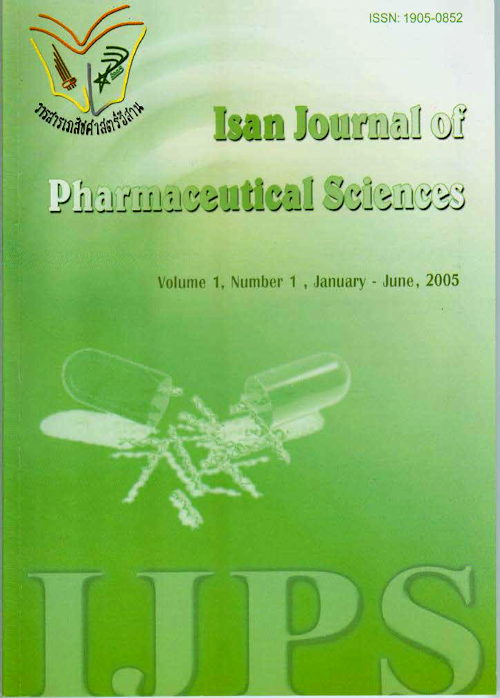Cost-Effectiveness Analysis of Celecoxib on an Avoidance of Gastrointestinal Adverse Events in Patients with Osteoarthritis
Main Article Content
Abstract
Gastrointestinal (GI) events are the common side effects of nonsteroidal anti-inflammatory drugs (NSAID). The adverse events including GI discomfort, symptomatic ulcer, and serious GI complications become an issue when the drugs are used in long term for chronic diseases like osteoarthritis. Celecoxib is one of the selective COX-2 inhibitors that its efficacy is comparable with the conventional NSAID but its GI side effects are relatively lower. However, expensive price of the drug is probably a major cause detering accessibility in those who cannot afford. This research aims to analyze cost-effectiveness of celecoxib in reducing the GI events, as compared with NSAID in combination with gastroprotective agents (GPA): either H-2 receptor antagonists (H2RA) or proton pump inhibitors (PPI). The incremental cost-effectiveness ratio (ICER) was determined based on health care provider perspective. Data on the effect on GI events of celecoxib and NSAID were obtained from a published study, Celecoxib Outcomes Measurement Evaluation Tools (COMET). Components of direct costs of health care due to the use of celecoxib and NSAID plus GPA were solicited from expert judgement. Unit prices of medication used were derived from electronic dispensing databases of 18 provincial hospitals. Decision Analysis Model was used to calculate the expected values of effectiveness and total cost for each alternative under a six-month time frame. Results from the reference case analysis revealed that use of celecoxib instead of NSAID (diclofenac) plus H2RA (ranitidine) in 1,000 hypothetical patients would incur an incremental cost of approximately 4.6 million Baht and reduce 40.2 events of any GI side effects. The amount was equivalent to the ICER of 114,975 Baht per GI event avoided. Compared with the use of NSAID plus PPI (omeprazole), ICER for celecoxib was as much as 948,611 Bahl for an event avoided, which was equal to an incremental cost of 3.4 million Baht for lowering 3.6 GI events in 1,000 patients. Celecoxib’s ICER was sensitive to Gl-evcnt risk categories of patients. To reduce the GI events caused by the conventional NSAID in Thailand, use of celecoxib may not be deemed cost-effective unless health policy makers are willing to pay for such high amount of Baht as indicated by the calculated ICER in this study.
Article Details
In the case that some parts are used by others The author must Confirm that obtaining permission to use some of the original authors. And must attach evidence That the permission has been included
References
Bcnsen W.G., Fiechtner J.J., McMillen J.I., Zhao W., Yu S.S., Woods E.M. (1999). Treatment of osteoathritis with celecoxib, a cyclooxygenase-2 inhibitor: a randomized controlled trial. Mayo Clin. Proc. 74: 1095-105.
Burke T.A., Zabinski R.A., Pettitt D. (2001). A framework for evaluating the clinical consequences of initial therapy with NSAIDs, NSAIDs plus gastroprotectivc agents, or celecoxib in the treatment of arthritis. Pharmacoeconomics. 19 Suppl 1: 33-47.
Chancellor J.V.M., Hunsche E., de Cruz E-, Sarasin F.P. (2001). Economic evaluation of celecoxib, a new cyclo-oxygenase 2 specific inhibitor, in Switzerland. Pharmacoeconomics. 19 Suppl 1: 59-75.
Fries J.F., Williams C.A., Bloch D.A. (1991) Nonsteroidal anti-inflammatory drug-associated gastropathy: incidence and risk factors. Am. J. Med. 91: 213-222.
Limwattananon S., Limwattananon C., Pannarunothai S. (2004). Rapid penetration of COX-2 inhibitors in nonsteroidal antiinflammatory drug market: an implication to hospital cost containment policy. Proceedings of the second International Conference on Improving Use of Medicine, Chiang Mai 30 Mar-2 Apr.
Marshall J.K., Pcllissier J.M., Attard C.L. (2001). Incremental cost-effectiveness analysis comparing rofccoxib with nonselcctivc NSAIDs in osteoarthritis: Ontario Ministry of Health perspective. Pharmacoeconomics 19: 1039-1049.

